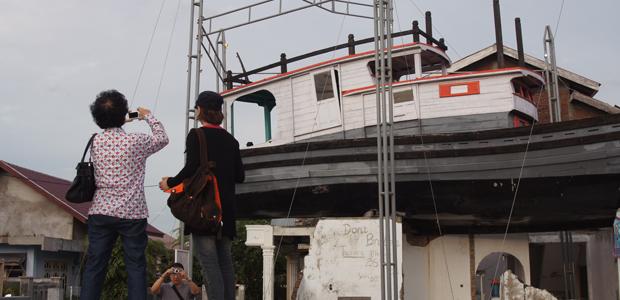Tsunami Tourism in Indonesia
The fishing vessel, used as a liferaft by 59 survivors, is a draw for tourists. (Photo: Niall Macaulay)
On December 26, 2004, a massive earthquake triggered a tsunami across the Indian Ocean that killed an estimated 230,000 people, many of them from the northern Sumatran province of Aceh.
Perhaps one of the most iconic images of the tsunami’s wrath was a 30-foot fishing boat thrown a couple of miles inland and perched on top the ruins of a house.
Fifty-nine people clung to the boat until the surge passed; all of them survived. There’s now a viewing platform above the building, and tsunami-related pictures on display below.
Ponny, who goes by one name as is the custom here in Indonesia, had seen the pictures but still wasn’t prepared for the reality:
“I think this is awesome!” Ponny said. “The people in this ship, nobody die, so this is a miracle.”
Ponny is among the growing numbers of tourists who have come to Aceh some seven years after the tsunami to see the relics of destruction. Around the wreckage, facilities have sprung up, with viewing platforms, drink vendors, and snack shops.
Petriani and her sister have opened a popular noodle shop under the beached boat. Petriani said after the tsunami this place became very well-known.
“That’s why my sister and I took the place. And word of mouth spread quickly, so people know the place and it’s easy to find us here,” Petriani said.
Across the street, 51-year-old Abdul Wahab sells drinks, snacks and souvenirs. He came here after the tsunami looking to make some money helping with the cleanup.
Now, he sits in front of his small shop serving thirsty tourists. He smiles at his good fortune, but said he sometimes he feels embarrassed, since it is such a sad place.
“I see people crying before they go up the platform,” Wahab said. “They remember what it was like here the day before the tsunami.”
About a mile away, the Aceh-Nias Rehabilitation and Reconstruction Agency, or BRR, built a $6.7 million Tsunami Museum. It exhibits photographs of victims, stories of survivors and an electronic simulation of the undersea earthquake that triggered the wave.
Spiritual Tourism
Officials say more tourists come to see the aftermath of the tsunami than come for the area’s wide, sandy beaches. Yusny Saby, a professor at the State Institute of Islamic Studies in Aceh, said it may sound morbid, but it’s actually very healing.
“We call it spiritual tourism,” Saby said. “If it were not for the tsunami, we would have still been in war. So the tsunami is a sort of blessing in disguise. We lost a lot, but it speeded up the process of bringing peace.”
The peace came after a nearly 30-year civil war between Acehnese rebels and the government of Indonesia. And that’s become another draw for tourists.
Zulkifi once worked as a tour guide in Jakarta and Bali, but he now teaches English and German to classes of future tour guides. Some of those guides-in-training spent years fighting for the rebels.
Zulkifi said before the tsunami, rebels holed up in the jungle. Now they’re engaged in guerrilla or “terror tourism.”
In fact, many western embassies still issue travel warnings for Aceh. There have been sporadic attacks targeting foreigners in recent years. But still the tourists come.
“I didn’t expect it, actually, how it looked like,” said Erlbrich Elsenga, who’s here from the Netherlands, looking up at the fishing boat on the house. “It’s different from what I expected, it is a big boat. I thought it was maybe a small boat on top of a small house, but really big.”
The scars of the tsunami are still not completely healed but the Acehnese hope they can at least get some benefit from the natural disaster that nearly wiped them out.
